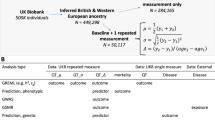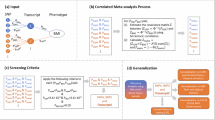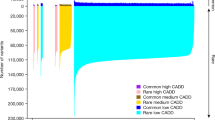Abstract
Although emerging sequencing technologies can characterize all genetic variants, the cost is still high. Illumina released the HumanOmni5M-4v1 (Omni5) genotype array with ~4.3M assayed SNPs, a much denser array compared with other available arrays. The Omni5 balances both cost and array density. In this article, we illustrate the power of Omni5 to detect genetic associations. The Omni5 includes variants with a wide range of minor allele frequencies down to <1%. The theoretical power calculation examples indicate the increased power of the Omni5 array compared with other arrays with lower density when evaluating associations with some known loci, although there are exceptions. We further evaluate the genetic associations between known loci and several quantitative traits in the Framingham Heart Study: femoral neck bone mineral density, lumbar spine bone mineral density and hippocampal volume. Finally, we search genome wide for novel associations using the Omni5 genotypes. We compare our association results from Affymetrix 500K+MIPS 50K arrays and two imputed data sets: (1) HapMap Phase II and (2) 1000 Genomes reference panel. We observed increased evidence for genotype–phenotype associations with smaller P-values for selected known loci using the Omni5 genotypes. With limited sample sizes, we identify novel variants with genome-wide significant P-values. Our observations support the notion that dense genotyping using the Omni5 can be powerful in detecting novel associated variants. Comparison with imputed data with higher density also suggests that imputation helps but cannot replace genotyping, especially when imputation quality is low.
Similar content being viewed by others
Log in or create a free account to read this content
Gain free access to this article, as well as selected content from this journal and more on nature.com
or
References
Marchini J, Howie B : Genotype imputation for genome-wide association studies. Nat Rev Genet 2010; 11: 499–511.
Li Y, Willer CJ, Ding J et al, MaCH: using sequence and genotype data to estimate haplotypes and unobserved genotypes. Genet Epidemiol 2010; 34: 816–834.
Li Y, Willer CJ, Sanna S, Abecasis G : Genotype imputation. Annu Rev Genomics Hum Genet 2009; 10: 387–406.
1000 Genomes Project Consortium, Abecasis GR, Auton A, Brooks LD et al: An integrated map of genetic variation from 1,092 human genomes. Nature 2012; 491: 56–65.
Kruglyak L : Prospects for whole-genome linkage disequilibrium mapping of common disease genes. Nat Genet 1999; 22: 139–144.
Dunning AM, Durocher F, Healey CS et al: The extent of linkage disequilibrium in four populations with distinct demographic histories. Am J Hum Genet 2000; 67: 1544–1554.
Abecasis GR, Noguchi E, Heinzmann A et al: Extent and distribution of linkage disequilibrium in three genomic regions. Am J Hum Genet 2001; 68: 191–197.
Pritchard JK, Przeworski M : Linkage disequilibrium in humans: models and data. Am J Hum Genet 2001; 69: 1–14.
Sham PC, Purcell SM : Statistical power and significance testing in large-scale genetic studies. Nat Rev Genet 2014; 15: 335–346.
Barrett JC, Cardon LR : Evaluating coverage of genome-wide association studies. Nat Genet 2006; 38: 659–662.
Pe'er I, de Bakker PI, Maller J, Yelensky R, Altshuler D, Daly MJ : Evaluating and improving power in whole-genome association studies using fixed marker sets. Nat Genet. 2006; 38: 663–667.
Li M, Li C, Guan W : Evaluation of coverage variation of SNP chips for genome-wide association studies. Eur J Hum Genet 2008; 16: 635–643.
Bhangale TR, Rieder MJ, Nickerson DA : Estimating coverage and power for genetic association studies using near-complete variation data. Nat Genet 2008; 40: 841–843.
Nelson SC, Doheny KF, Pugh EW et al: Imputation-based genomic coverage assessments of current human genotyping arrays. G3 (Bethesda) 2013; 3: 1795–1807.
Estrada K, Styrkarsdottir U, Evangelou E et al: Genome-wide meta-analysis identifies 56 bone mineral density loci and reveals 14 loci associated with risk of fracture. Nat Genet 2012; 44: 491–501.
Bis JC, DeCarli C, Smith AV et al: Common variants at 12q14 and 12q24 are associated with hippocampal volume. Nat Genet. 2012; 44: 545–551.
Acknowledgements
We would like to acknowledge the work of Larry Atwood for his early efforts in connecting Illumina and Boston University. Genotyping of ~4.3M SNPs was conducted in subset of 2500 Framingham Offspring Cohort participants using the Illumina HumanOmni5M-4v1 array designed to target variation down to 1% minor allele frequency. This genotyping was produced at no charge by Illumina under an agreement between Illumina and Boston University. This work was supported by the National Heart, Lung and Blood Institute’s Framingham Heart Study (Contract no. N01-HC-25195) and its contract with Affymetrix, Inc for genotyping services (Contract no. N02-HL-6-4278). A portion of this research utilized the Linux Cluster for Genetic Analysis (LinGA-II) funded by the Robert Dawson Evans Endowment of the Department of Medicine at Boston University School of Medicine and Boston Medical Center. This study was also supported by grants from the NINDS (NS17950), the NHLBI (HL102419, HL096917) and the NIA (AG08122, AG16495, AG033193). Additional support for the skeletal phenotypes was obtained from NIAMS (R01 AR/AG 41398).
Web resources
RefGene and KnownGene can be found from http://genome.ucsc.edu/ using GRCh37or hg19. SNAP Proxy Search can be found from http://www.broadinstitute.org/mpg/snap/ldsearch.php
Data access number
The dbGaP accession number for the Illumina HumanOmni5M-4v1 data reported in this paper is phs000342.v13.p9.
Author information
Authors and Affiliations
Corresponding authors
Ethics declarations
Competing interests
The authors declare no conflict of interest.
Additional information
Supplementary Information accompanies this paper on European Journal of Human Genetics website
Supplementary information
Rights and permissions
About this article
Cite this article
Xing, C., Huang, J., Hsu, YH. et al. Evaluation of power of the Illumina HumanOmni5M-4v1 BeadChip to detect risk variants for human complex diseases. Eur J Hum Genet 24, 1029–1034 (2016). https://doi.org/10.1038/ejhg.2015.244
Received:
Revised:
Accepted:
Published:
Issue date:
DOI: https://doi.org/10.1038/ejhg.2015.244



